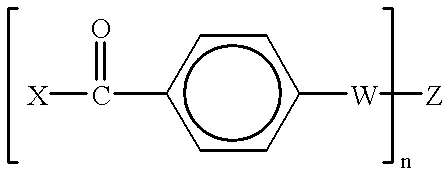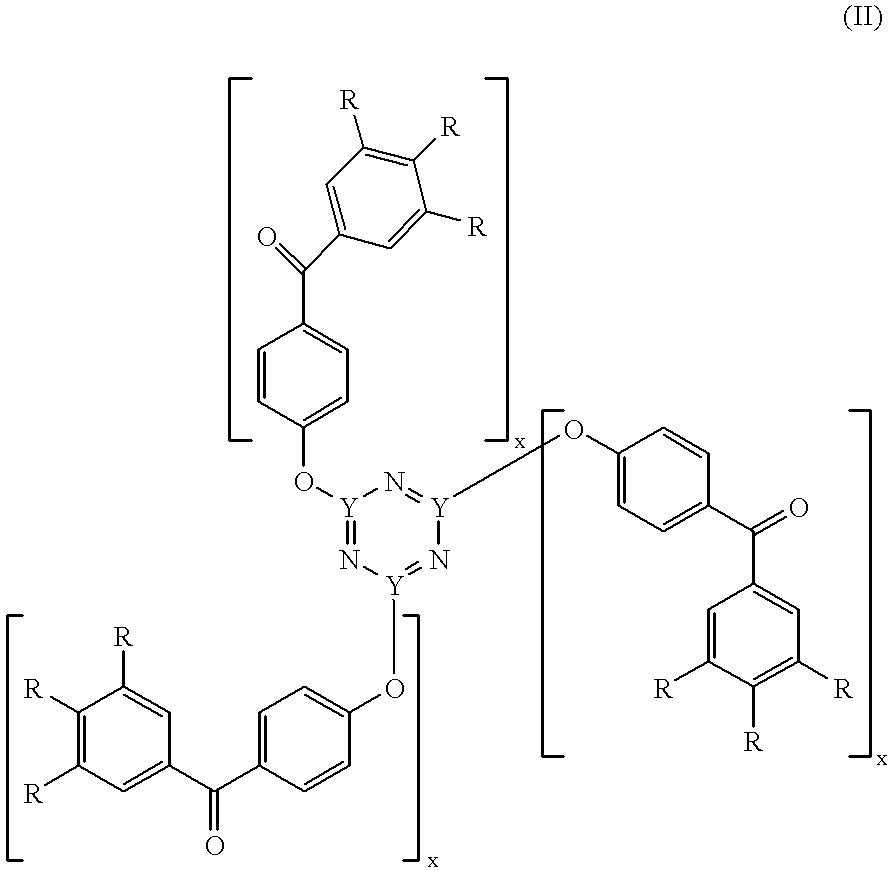Radiation-crosslinkable elastomers and photocrosslinkers therefor
a technology of elastomers and crosslinkers, which is applied in the field of radio-crosslinkable elastomers and photo-crosslinkers therefor, can solve the problems of high volatility, incompatibility with certain polymer systems, and generation of corrosive or toxic by-products
- Summary
- Abstract
- Description
- Claims
- Application Information
AI Technical Summary
Problems solved by technology
Method used
Image
Examples
example 1
Preparation of C5EBP
4-hydroxybenzophenone (3000 g; 15.15 moles), NaOH (608 g; 15.15 moles) and ethylene glycol (5500 g) were placed in a 12 liter flask fitted with a condenser and mechanical stirrer. The reaction mixture was stirred at 85.degree. C. until the 4-hydroxybenzophenone and the NaOH were dissolved. The reaction mixture was then set to 135.degree. C. and 2000 g (8.6 moles) of 1,5-dibromopentane was added. Excess NaOH (80 g, 2.05 moles) was added in portions to maintain a basic pH. After heating for 1.5 hours, the reaction was essentially complete. The mixture was cooled by the addition of 2500 g water and the precipitated product was filtered from the ethylene glycol / water mixture. This tan, solid precipitate was then mixed with 3608 g ethyl acetate to purify the product. This ethyl acetate purification step was repeated and, following air drying, 2982 g of the purified C5EBP product was obtained.
example 2
Preparation of Bis(benzophenone) Analogs
Bis(benzoplhenone) analogs of C5EBP were prepared in accordance with Example 1 by replacing the 1,5-dibromopentane with equimolar amounts of the following dibromo-substituted starting materials:
example 3
Preparation of 2,4,6-tri(4-benzoylphenoxy)-1,3,5-triazine (TBPT)
A 500 ml 3-neck Morton flask was equipped with mechanical stirring apparatus, a thermometer, and a pressure-equalizing addition funnel (PEAF). The flask was charged with 23.0 g bromine (Br.sub.2, 144 mmole) and 75 ml distilled water (H.sub.2 O). While being stirred, the flask and contents were cooled to less than 0.degree. C. with an external ice-salt water bath. The PEAF was charged with 7.00 g sodium cyanide (NaCN, 143 mmole) dissolved in 50 ml H.sub.2 O. The NaCN solution was added dropwise over 15 minutes to the vigorously stirred cold Br.sub.2 solution so that the temperature remained less than 5.degree. C. The brown Br.sub.2 color was and replaced by a yellow color as the addition progressed. Stirring continued about 15 minutes past the end of addition, during which time the temperature fell to below 0.degree. C. A mixture (slurry) of 26.75 g 4-hydroxybenzophenone (135 mmole) in 150 ml chloroform (CHCl.sub.3) was ...
PUM
| Property | Measurement | Unit |
|---|---|---|
| wavelength | aaaaa | aaaaa |
| wavelength | aaaaa | aaaaa |
| width | aaaaa | aaaaa |
Abstract
Description
Claims
Application Information
 Login to View More
Login to View More - R&D
- Intellectual Property
- Life Sciences
- Materials
- Tech Scout
- Unparalleled Data Quality
- Higher Quality Content
- 60% Fewer Hallucinations
Browse by: Latest US Patents, China's latest patents, Technical Efficacy Thesaurus, Application Domain, Technology Topic, Popular Technical Reports.
© 2025 PatSnap. All rights reserved.Legal|Privacy policy|Modern Slavery Act Transparency Statement|Sitemap|About US| Contact US: help@patsnap.com



